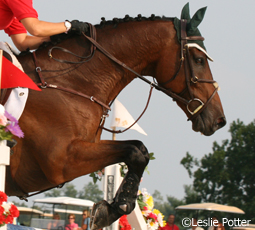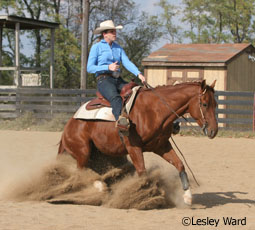 Your horse’s joints take a pounding. Everyday wear and tear can cause cumulative damage, plus there’s the risk of trauma that increases with athletic demands. Soundness and performance suffer as a result of joint-related issues. However, joint damage can start well before visible signs appear. Awareness of your horse’s joint health is important, but equine joint anatomy and the science associated with care options can be mind-boggling. Here is a guide to the key words that will help you translate the vet-speak and understand the treatment and prevention of various joint problems.
Your horse’s joints take a pounding. Everyday wear and tear can cause cumulative damage, plus there’s the risk of trauma that increases with athletic demands. Soundness and performance suffer as a result of joint-related issues. However, joint damage can start well before visible signs appear. Awareness of your horse’s joint health is important, but equine joint anatomy and the science associated with care options can be mind-boggling. Here is a guide to the key words that will help you translate the vet-speak and understand the treatment and prevention of various joint problems.
The “typical” joint is made up of at least two bones, which are covered with articular cartilage on the parts that lie within the joint. This cartilage provides a smooth surface for the joint interface, protects the ends of the bones and cushions them during joint movement. Articular cartilage is made up of water, collagen (a type of connective tissue) and proteoglycans—large molecules made up of a protein core and carbohydrate chains called glycosaminoglycans, which bind the water within the cartilage, giving it unique shock-absorbing qualities.
The entire joint is surrounded by the joint capsule, which is composed of tough ligaments (the fibrous joint capsule) and the synovial membrane lining. The fibrous joint capsule supports and protects the joint, while the synovial membrane secretes synovial fluid (joint fluid), a slippery, thick liquid that lubricates the joint to facilitate movement and supplies the cartilage with the substrates it needs to function properly. It’s important to understand that each of these components is essential for normal joint function.
The Glossary
Now that we’ve reviewed basic joint anatomy and function, let’s take a look at some specific terms.
|
Arthritis (osteoarthritis, degenerative joint disease): Inflammation of a joint caused by trauma, developmental disease (such as osteochondrosis in young horses, see pg. 59) or, less commonly, infection. If untreated, arthritis can cause progressive destruction of the joint because the inflammation triggers the release of active substances such as enzymes, cytokines and prostaglandins from the synovial membrane and cartilage cells. These substances damage the articular cartilage and alter the secretion and composition of the synovial fluid. This leads to further inflammation, creating a cycle of increasing damage that eventually affects all parts of the joint, causing pain and limiting performance.
Arthrodesis: Fusion of a joint, which keeps it from moving, thereby eliminating the pain of osteoarthritis. Arthrodesis is used as a treatment for osteoarthritis only in joints with limited movement, such as the pastern joint (high ringbone) or the lowest joint in the hock (bone spavin). Arthrodesis of the hock can be achieved with intra-articular (into the joint) injection of ethyl alcohol, but surgery is usually needed to fuse other joints. Arthrodesis can also occur spontaneously as a result of osteoarthritis or injury.
Arthroscopy: A surgical procedure in which the veterinarian inserts an arthroscope—a small instrument containing a lens and fiber optic lighting system—into a joint to diagnose or treat a problem, such as bone or cartilage chips in the knee (carpus). Arthroscopic procedures cause less joint trauma and fewer post-operative complications than operations that require more extensive incisions into the joint.
Capsulitis: Inflammation of the fibrous joint capsule caused by repeated trauma. One of the earliest signs of joint damage, capsulitis can stimulate the release of harmful inflammatory substances, enzymes and cytokines (see pg. 54), which cause even more damage to the joint.
Chondroitin sulfate: The primary glycosaminoglycan found in the proteoglycans of the joint cartilage. Chondroitin sulfate is also used as a dietary supplement, intended to replenish proteoglycan levels that have been reduced by joint injury and subsequent inflammation.
Corticosteroids (cortisone): Compounds such as betamethasone, triamcinolone (Vetalog) and methylprednisolone acetate (Depo-Medrol) that are sometimes injected intramuscularly (into the muscle) or intra-articularly (into the joint) by your vet to decrease the inflammation and pain associated with joint disorders such as capsulitis, synovitis and osteoarthritis. Corticosteroids must be used properly to avoid further joint damage and other undesirable side effects, such as laminitis.
Cytokines: Compounds released by a cell that affect the function of other cells. In osteoarthritis, cytokines that are released in response to the inflammation cause other cells in the joint to release harmful enzymes and other destructive substances. This causes more inflammation, which leads to the release of even more cytokines, creating a cycle of continuing damage.
Enthesophyte: A proliferation of bone—sometimes called a bone spur—that forms in response to ligament damage at the point where the joint capsule attaches to the bone. The amount of pain caused by an enthesophyte depends on the severity of the ligament damage.
Enzymes: Compounds that trigger a chemical reaction without being altered by the reaction. In synovitis or osteoarthritis, enzymes secreted by the inflamed synovial membrane damage the joint cartilage.
Essential fatty acids: Fats that must be obtained from the diet. Omega-3 fatty acids, which are abundant in fish oil, flaxseed and sunflower seeds, promote joint health and decrease inflammation in joint disorders such as synovitis, capsulitis, and osteoarthritis. Omega-6 fatty acids are also essential, but they don’t seem to have the same type of protective effects on joints.
Fracture: This term usually refers to a broken bone, but cartilage can also “break” (for example, in osteochondrosis). If a fracture involves a joint, the outlook for recovery depends on the size and location of the fracture, the damage to the joint, and the treatment.
Glucosamine: A compound naturally occurring in joint cartilage that serves as a building block for components of the cartilage and hyaluronic acid (see next definition). Oral glucosamine has been shown to reduce inflammation and relieve pain in humans with osteoarthritis. Veterinarians and horse owners have reported similar results in equines, but most research studies have focused on the effects of glucosamine on equine cartilage cells rather than live animals. Questions also remain about the amount of orally administered glucosamine that can be used by the body.
 Hyaluronic acid: A glycosaminoglycan that is a normal component of synovial fluid and joint cartilage. Hyaluronic acid (also known as sodium hyaluronate or hyaluronan) gives the synovial fluid its viscosity and helps lubricate the joint during movement. In the cartilage, it serves as a backbone for groups of proteoglycan molecules that impart qualities of cushioning and resiliency.
Hyaluronic acid: A glycosaminoglycan that is a normal component of synovial fluid and joint cartilage. Hyaluronic acid (also known as sodium hyaluronate or hyaluronan) gives the synovial fluid its viscosity and helps lubricate the joint during movement. In the cartilage, it serves as a backbone for groups of proteoglycan molecules that impart qualities of cushioning and resiliency.
Joint disease can lead to a reduction in the amount of hyaluronic acid, as well as its function. Veterinarians often prescribe intravenous or intra-articular hyaluronic acid, also known as sodium hyaluronate (for example, Legend, Hyvisc or Hyalovet) for osteoarthritis; the efficacy of these treatments has been demonstrated both clinically and in research studies. The evidence supporting oral administration of hyaluronic acid is less well-defined, although some beneficial effects have been reported.
Intra-articular injection: A procedure in which medication is injected directly into the joint. Depending on the problem being treated, the medication may be polysulfated glycosaminoglycan, hyaluronic acid, corticosteroid or antibiotic. Intra-articular injections should only be performed by a veterinarian. Possible complications include joint trauma, needle breakage and infection.
IRAP therapy: A recent innovation for the treatment of osteoarthritis, this therapy uses a protein called interleukin-1 receptor antagonist protein (IRAP) to block sites on cartilage cells where harmful enzymes and cytokines attach to trigger damaging reactions. The treatment, which involves a series of intra-articular injections, has shown promising results, even in advanced cases of osteoarthritis.
Joint mouse: A small fragment of bone or cartilage (for instance, from a chip fracture or damaged cartilage) that moves about within the joint. Depending on its location, a joint mouse can cause severe pain, or none at all.
Ligaments: Tough connective tissue fibers that completely surround the joint, forming the fibrous joint capsule. Ligaments, which hold the bones of the joint together, keep the bones properly aligned, stabilize the joint and protect its interior structures. Damage to the ligaments where they attach to the bones can cause pain, bleeding, swelling and microscopic fractures.
Methylsulfonylmethane (MSM): A sulfur-containing compound used in many different oral joint-health supplements. Although the efficacy of MSM hasn’t been conclusively proven, some studies indicate that it may help prevent joint stress. This effect may be related to its sulfur content; sulfur is an important component of many types of connective tissue, including ligaments and hooves.
Neurectomy: A surgical procedure in which the veterinarian cuts a nerve to relieve the pain associated with lameness. Neurectomy of the posterior digital nerve was once widely used to relieve the pain of navicular syndrome, but the procedure has fallen from favor because of its potential complications, such as the formation of benign but painful tumors (neuromas) at the surgery site.
Non-steroidal anti-inflammatory drugs (NSAIDs): Medications that are used to relieve the inflammation and pain of various types of joint disorders. NSAIDs affect the enzymes that control the release of prostaglandins (compounds involved in various bodily functions, including blood pressure regulation, stomach acid secretion and inflammation) in the joints and elsewhere in the body.
Prostaglandins controlled by the enzyme COX-1 participate in many normal bodily functions, including maintenance of the protective lining of the digestive tract. Other prostaglandins, controlled by the COX-2 enzyme, mediate pain and inflammation. Some NSAIDs, such as phenylbutazone (“bute”) and flunixin meglumine (Banamine), inhibit both COX-1 and COX-2, potentially causing adverse side effects (digestive tract ulceration and kidney damage). Others, such as firocoxib (Equioxx), inhibit primarily COX-2 to provide superior pain relief with fewer adverse effects. Administration of any NSAID can cause further joint injury if the pain relief leads to overexertion. As with all medications, NSAIDs should only be administered with the recommendation of a veterinarian.
Unlike oral or injectable products, diclofenac cream (Surpass) is an NSAID that’s rubbed into the skin over the affected joint. The medication is then absorbed and carried directly to the joint. This means that the treatment is concentrated right where it’s needed, not in other areas of the body. NSAID-related side effects can still occur, however, so use this product only if your veterinarian prescribes it.
|
Nutraceuticals: Dietary compounds (supplements) that are thought to have pharmaceutical properties. Examples of nutraceuticals used to treat equine joint problems include glucosamine, chondroitin sulfate, MSM and vitamin C. The rationale for using these compounds is based primarily on the positive results found in human research studies. Similar evidence in horses is lacking, but some owners and veterinarians have reported beneficial effects.
Osteochondrosis: A developmental disorder in young horses thought to stem from an abnormality in the transformation of cartilage into bone during growth. Associated factors include overfeeding, mineral imbalance, rapid growth and, in some cases, trauma to the cartilage. If a fracture of the cartilage occurs, the condition is known as osteochondritis dissecans. If untreated, these conditions can lead to osteoarthritis and permanent disability.
Osteophyte: A proliferation of bone (a bone spur) that forms in an arthritic joint at the junction of the articular cartilage and the bone. Osteophyte formation is the body’s attempt to stabilize the joint as osteoarthritis damages the cartilage, making it progressively thinner.
Polysulfated glycosaminoglycan (PSGAG or “P-GAG”; Adequan): An injectable medication, Adequan is a polysulfated glycosaminoglycan molecule derived from chondroitin sulfate that inhibits the release of inflammatory prostaglandins and enzymes in osteoarthritic joints. PSGAG also promotes cartilage healing and function by increasing the production of hyaluronic acid, proteoglycan and collagen. The medication can be administered directly into the joint or by intramuscular injection, a more widely used technique.
Synovitis: Inflammation of the synovial membrane of the joint in response to repeated trauma. Synovitis (along with capsulitis) is one of the earliest signs of joint damage; the resulting pain and swelling—which may be subtle, at least initially—can contribute to the release of inflammatory substances, enzymes and cytokines, thereby leading to further joint damage.
With an understanding of these terms, you’ll be better equipped to talk to your vet about diagnosis and treatment options for maintaining or restoring your horse’s joint health.
Karla S. Rugh, D.V.M., Ph.D., is a horse owner, freelance writer and author based in Rocheport, Missouri.
This article originally appeared in the January 2010 issue of Horse Illustrated. Click here to subscribe.






Interesting! I hope that everyone’s weekend is both great and safe.plus I hope that they had a nice Earth Day. That goes for last year and all the other years that I’ve missed. That goes for Arbor Day,as well.
I found this very helpful, and have filed it away in my computer. I just purchased a horse and withing 1 week was having leg problems (trainer said ring bone)… wish I could have had this article about a month ago. (BTW my horse wasn’t lame and it WASN’T ring bone) 🙂
Thank you for this article. I have printed it out and added to my notebook…
Great article.